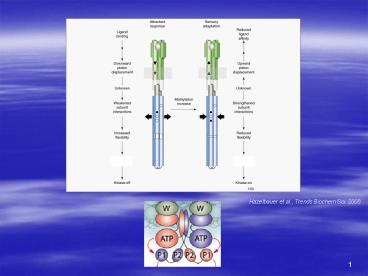Bacterial Signal Transduction PowerPoint PPT Presentation
1 / 33
Title: Bacterial Signal Transduction
1
(No Transcript)
2
CheA is autophosphorylated
3
Swimming bacteria
- http//www.rowland.org/labs/bacteria/showmovie.php
?movswimming_ecoli
Howard Berg
4
(No Transcript)
5
The phosphotransfer reaction of 2-component
systems
(CheA)
(CheY/CheB)
(CheZ)
6
Rec response regulator receiver contains the
phophorylated Asp Most response regulators have
a C-terminal DNA binding domain (HTH), but a
few, like CheB have enzymatic activity
7
Anand, G. S. et al., 1998. Activation of
methylesterase CheB evidence of a dual role for
the regulatory domain. Biochemistry 37
14038-14047.
8
- There was evidence that the N-term. domain acts
to inhibit C-term. methylesterase activity
9
Che Bc
The Evidence
- Proteolysis of CheB produces CheBc, which has
10-fold higher methylesterase activity than the
unphosphorylated intact protein, and similar to
CheBP
10
Question?
Big question What is the nature of stimulation
by phosphorylation? Specific question Which
regions on the C-terminal domain are involved in
inhibitory interactions with the N-terminal
domain?
Approach
Identify mutations outside the regulatory domain
that relieve inhibition in the absence of
phosphorylation
11
Methods
- Mutagenesis of CheB
- 1. Make an unphosphorylatable protein
- 2. Isolate activated mutants of CheB D56N
- Chemotaxis plate assay (Swarm assay)
- Methylesterase Assay
12
CheB (D56N)
- Asp56 is the site of phosphorylation
- Substituted Asp(D) with Asn(N)
13
Methods
- Mutagenesis of CheB
- 1. Make a unphosphorylatable protein
- 2. Isolate activated mutants of CheB D56N
- Chemotaxis plate assay (Swarm assay)
- Methylesterase Assay
14
Mutagenize CheB (D56N)
- PCR mutagenized DNA region outside N-terminal
domain and inserted back
15
Assays
- Mutagenesis of CheB
- Chemotaxis plate assay (Swarm assay)
- Methylesterase Assay
16
Chemotaxis a s s a y
Compared diameters of mutants to that of CheBc
and CheB D56N
17
- CheBc was active at low levels
- CheB D56N was active at high levels
Swim
What is the significance of these data?
18
Chemotaxis a s s a y
Compared diameters of mutants to that of CheBc
and CheB D56N 8/1200 mutants were chosen for
further study
19
Many mapped in the linker region.
20
Assays
- Mutagenesis of CheB
- Chemotaxis plate assay (Swarm assay)
- Methylesterase Assay
21
CheB is both a methyl esterase as well as a
deamidase
22
Glutamic acid
Glutamine
Q
E
23
(No Transcript)
24
M e t h y l e s t e r a s e a s s a y
1. To assay activity of CheB upon
phosphorylation, CheB was pre-incubated in
presence of phosphoramidate before addition to
radiolabeled Tar.
2. Membrane bound Tar receptors were radiolabeled
with H3-methyl groups (CheR SAM). Then
incubated these with CheB or its derivatives.
25
Activities are relative to CheBc 1. Mutants have
2-3 fold higher activty than CheB
(unphoshorylated) 2. Phosphorylated CheB has
higher methylesterase activity than CheBc
26
Che Bc
- Proteolysis of CheB produces CheBc, which has
10-fold higher methylesterase activity than the
unphosphorylated intact protein, and similar to
the phosphorylated form
27
- The fact that the CheBs activity was enhanced in
the presence of phosphoramidate to levels above
those obtained from the CheBc (which lacks the
the N-terminal) suggests that phosphorylation not
only relieves inhibition but has an additional
stimulatory function.
28
C o n c l u s i o n s
- 1. N-terminal domain plays a dual role in
regulation of methylesterase activity - Phosphorylation both relieves inhibition as
well as stimulates methylesterase activity of the
C-terminal domain. - 2. Stimulation of methylesterase activity by
mutations in the linker region suggest this must
propagate the conformation chage or move during
CheB activation by phosphorylation - 3. CheB has an intrinsic methylesterase activity
in the absence of phosphorylation (Table 2)
29
M o d e l for CheB activation
- CheB can exist in two conformations - a closed,
less active state and an open, more active state.
Phosphorylation shifts the equilibrium to the
open state
30
Adaptation
Methylation neutralizes negative charges
31
Methylated receptors stimulate CheA Unmethylated
receptors inhibit CheA
32
Attractant binding changes conformation of
receptors. CheA is inhibited. Cells swim
smoothly. At the same time, E residues on
receptors are exposed for methylation. CheR,
which is always available, methylates Es. CheA
gets stimulated. CheYP allows cells to return to
normal run-tumble bias. CheBP removes methyl
groups to return receptors to pre-stimulus
conformation. The steady-state level of
methylation is determined by methylation-demethyla
tion rates.
33
(No Transcript)

